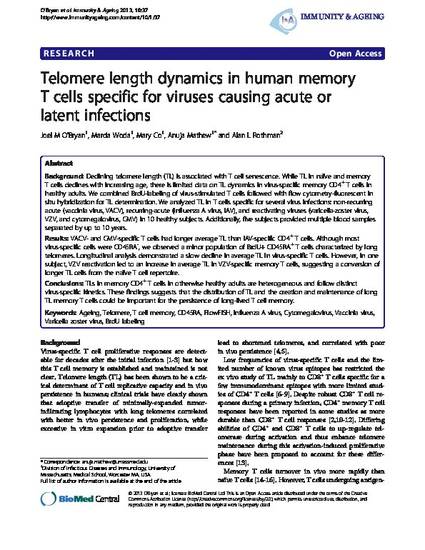
BACKGROUND: Declining telomere length (TL) is associated with T cell senescence. While TL in naive and memory T cells declines with increasing age, there is limited data on TL dynamics in virus-specific memory CD4+ T cells in healthy adults. We combined BrdU-labeling of virus-stimulated T cells followed with flow cytometry-fluorescent in situ hybridization for TL determination. We analyzed TL in T cells specific for several virus infections: non-recurring acute (vaccinia virus, VACV), recurring-acute (influenza A virus, IAV), and reactivating viruses (varicella-zoster virus, VZV, and cytomegalovirus, CMV) in 10 healthy subjects. Additionally, five subjects provided multiple blood samples separated by up to 10 years.
RESULTS: VACV- and CMV-specific T cells had longer average TL than IAV-specific CD4+ T cells. Although most virus-specific cells were CD45RA-, we observed a minor population of BrdU+ CD45RA+ T cells characterized by long telomeres. Longitudinal analysis demonstrated a slow decline in average TL in virus-specific T cells. However, in one subject, VZV reactivation led to an increase in average TL in VZV-specific memory T cells, suggesting a conversion of longer TL cells from the naive T cell repertoire.
CONCLUSIONS: TLs in memory CD4+ T cells in otherwise healthy adults are heterogeneous and follow distinct virus-specific kinetics. These findings suggests that the distribution of TL and the creation and maintenance of long TL memory T cells could be important for the persistence of long-lived T cell memory.
- Ageing,
- Telomere,
- T cell memory,
- CD45RA,
- FlowFISH,
- Influenza A virus,
- Cytomegalovirus,
- Vaccinia virus,
- Varicella zoster virus,
- BrdU labeling
Available at: http://works.bepress.com/alan_rothman/4/